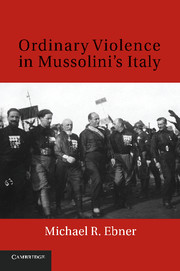Book contents
- Frontmatter
- Dedication
- Contents
- Tables and Figures
- Acknowledgments
- Common Abbreviations in Text and Notes
- Introduction: The Fascist Archipelago
- 1 Squad Violence
- 2 Institutions of Fascist Violence
- 3 Breaking the Anti-Fascists, 1926-1934
- 4 The Archipelago
- 5 The Politics of Pardons
- 6 Everyday Political Crime
- 7 Ordinary Fascist Violence
- 8 The Politics of Everyday Life
- Conclusion
- Bibliography
- Index
2 - Institutions of Fascist Violence
Published online by Cambridge University Press: 05 July 2014
- Frontmatter
- Dedication
- Contents
- Tables and Figures
- Acknowledgments
- Common Abbreviations in Text and Notes
- Introduction: The Fascist Archipelago
- 1 Squad Violence
- 2 Institutions of Fascist Violence
- 3 Breaking the Anti-Fascists, 1926-1934
- 4 The Archipelago
- 5 The Politics of Pardons
- 6 Everyday Political Crime
- 7 Ordinary Fascist Violence
- 8 The Politics of Everyday Life
- Conclusion
- Bibliography
- Index
Summary
The police have heavy treads and firm voices. They entered the Via del Corno with the familiarity and self-assurance of boxers coming into the ring. It was the usual patrol, checking up on those not supposed to be out after nightfall [gli ammoniti].
Vasco Pratolini, A Tale of Poor Lovers (1947)The exceptional decrees of 1926 marked the definitive institutional rupture between the liberal constitutional order and the new Fascist police state. The public-security code, although based largely on its liberal predecessor, nevertheless substantially curtailed individual rights, subordinating them to the interests of the state. More than the legislation itself, it was the intentions of regime officials who implemented it that gave the dictatorship its Fascist character. According to Mussolini's new police chief, Arturo Bocchini, the police would now play a “more decisive and beneficial role in improving and transforming the habits of the Nation in keeping with the ethical and social principles that form the Fascist State.” The new regime planned to use the public-security forces “to control activities once left to the initiative of individuals.” Police understood that, above all, the new legislation ordered them to ruthlessly suppress anti-Fascist groups and to facilitate the expansion of the National Fascist Party (PNF). However, police officials also correctly determined that the new law gave state authorities the right to intervene in an undefined set of public and private arenas in order to bring the nation into line with the “ethics” and “principles” of Fascism.
- Type
- Chapter
- Information
- Ordinary Violence in Mussolini's Italy , pp. 48 - 71Publisher: Cambridge University PressPrint publication year: 2010



